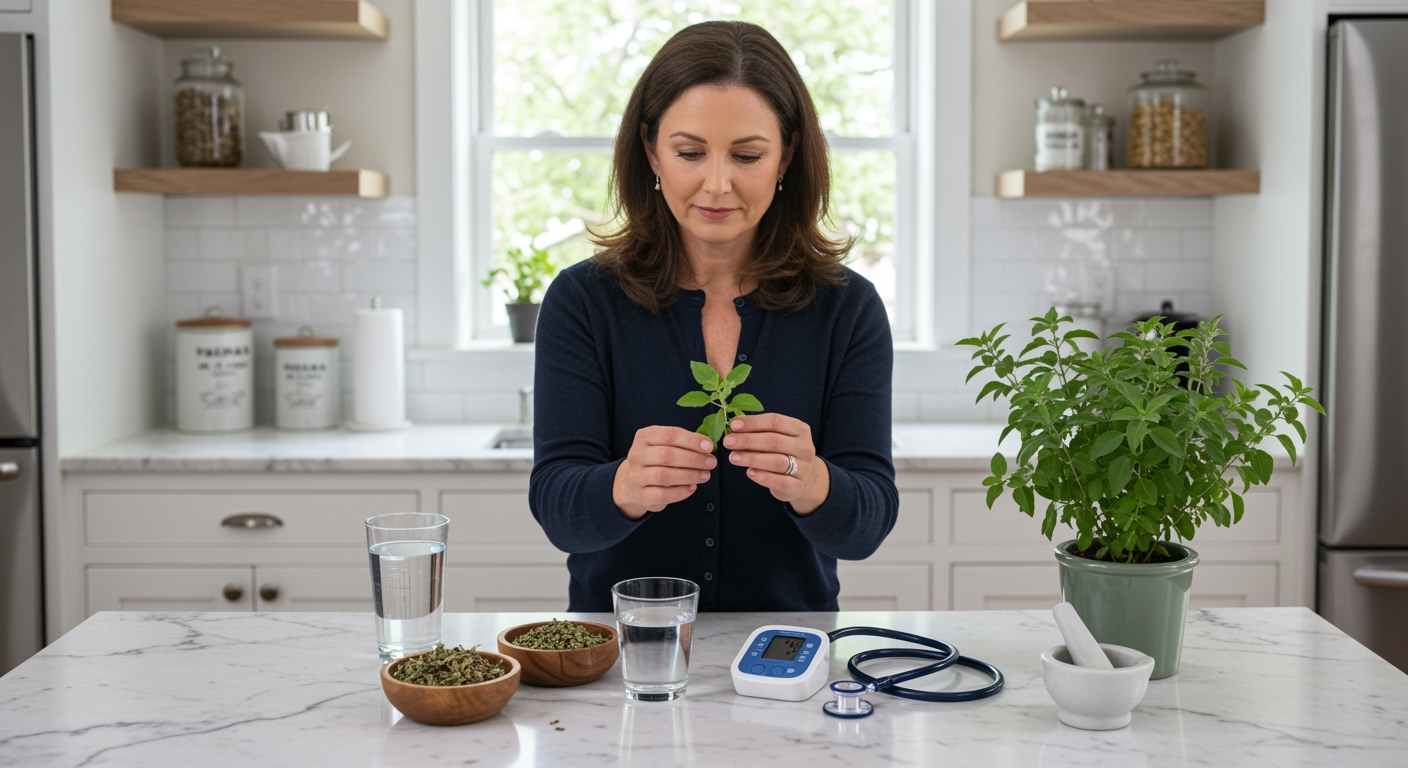✪ Key Takeaway: Tulsi may lower blood pressure further in people with hypotension, potentially causing dizziness and weakness.
Introduction
Your doctor just told you that your blood pressure runs low, and now you are wondering if that tulsi tea you love so much is helping or hurting you.
This question makes perfect sense because tulsi gets praised for its blood pressure benefits, but most information focuses on high blood pressure rather than low blood pressure.
Hi, I am Abdur, your nutrition coach, and today I am going to explain exactly how tulsi affects low blood pressure and whether you should continue using it.
What Does Tulsi Actually Do To Blood Pressure?
Tulsi contains eugenol and other active compounds that work as natural calcium channel blockers in your cardiovascular system.
These compounds help relax the smooth muscles in your blood vessel walls, which naturally leads to wider arteries and lower blood pressure readings.
Research shows that tulsi can reduce both systolic and diastolic blood pressure by approximately 10-15 mmHg in people with normal to high blood pressure.
The herb also contains antioxidants like rosmarinic acid that protect your blood vessels from damage and improve overall circulation.
Your body responds to tulsi within 30-60 minutes after consumption, and the blood pressure lowering effects can last for several hours.
This mechanism works the same way regardless of whether your starting blood pressure is high, normal, or already low.
✪ Fact: Tulsi can lower blood pressure by 10-15 mmHg regardless of your starting blood pressure level.
Why Low Blood Pressure Makes Tulsi Risky?
Low blood pressure, also called hypotension, means your blood pressure readings consistently fall below 90/60 mmHg.
When you already have low blood pressure and consume tulsi, your blood pressure can drop even further into dangerous territory.
This additional drop can cause insufficient blood flow to your brain, heart, and other vital organs that need constant oxygen and nutrients.
Your body tries to compensate by increasing your heart rate, but this creates additional stress on your cardiovascular system.
The combination of low blood pressure and tulsi consumption can trigger symptoms like dizziness, lightheadedness, fainting, nausea, and extreme fatigue.
Some people with hypotension who use tulsi regularly report feeling weak and unable to perform normal daily activities effectively.
✪ Pro Tip: Monitor your blood pressure for one week after stopping tulsi to see if your energy levels improve.
What Symptoms Should You Watch For?
The most common symptom of tulsi-induced blood pressure drops is dizziness when you stand up quickly from sitting or lying down.
You might also experience blurred vision, especially during the first hour after consuming tulsi tea or supplements.
Many people report feeling unusually tired or weak throughout the day, even after getting adequate sleep the night before.
Nausea and mild headaches can occur when your brain does not receive enough oxygenated blood due to low blood pressure.
Some individuals experience cold hands and feet because reduced blood pressure affects circulation to your extremities.
In severe cases, you might feel confused or have difficulty concentrating on simple tasks that normally come easily to you.
These symptoms typically appear within 1-2 hours after consuming tulsi and can persist for 4-6 hours depending on the amount consumed.
✪ Note: If you experience fainting or severe dizziness with tulsi, stop using it immediately and consult your doctor.
Are There Any Safe Ways To Use Tulsi With Low Blood Pressure?
The safest approach for people with low blood pressure is to avoid tulsi completely until their blood pressure normalizes.
If you absolutely want to try tulsi, start with extremely small amounts like one fresh leaf per day and monitor your symptoms carefully.
Never consume tulsi on an empty stomach because this can amplify its blood pressure lowering effects significantly.
Consider using tulsi only during times when you can rest and do not need to drive or operate machinery for several hours.
Some people find that consuming tulsi with meals helps buffer its effects, but this strategy does not eliminate the risks entirely.
Always check your blood pressure before and after trying any amount of tulsi to understand how your body responds individually.
✪ Pro Tip: Keep a blood pressure log when experimenting with tulsi to track patterns and identify safe amounts.
What Should You Use Instead Of Tulsi?
Focus on herbs and foods that can help raise your blood pressure naturally rather than lower it further.
Licorice root contains compounds that can increase blood pressure by affecting your body’s sodium and potassium balance.
Increasing your salt intake moderately can help raise blood pressure, but discuss this with your doctor first to avoid overdoing it.
Drinking more water throughout the day helps increase blood volume, which naturally raises blood pressure readings.
Small amounts of caffeine from coffee or green tea can provide temporary blood pressure increases when you need them most.
Regular exercise, especially strength training, helps improve circulation and can gradually increase your baseline blood pressure to healthier levels.
✪ Fact: Licorice root can raise blood pressure by 10-15 mmHg, making it a better choice than tulsi for hypotension.
The Bottom Line
Tulsi is not a good choice for people with low blood pressure because it can make hypotension worse and cause uncomfortable symptoms.
Smart nutrition means choosing herbs that work with your body’s needs, not against them.
I would love to hear about your experiences with tulsi and low blood pressure, so please share your questions or thoughts in the comments below.
References
At NutritionCrown, we use quality and credible sources to ensure our content is accurate and trustworthy. Below are the sources referenced in creating this article:





